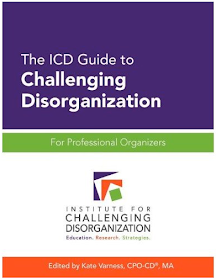
ICD? That's the Institute for Challenging Disorganization, previously known as the National Study Group on Chronic Disorganization. If you're not a professional organizer, you may never have heard of the ICD. If you are a professional organizer, though, the ICD is an organization you'll want to know about.
I've been a subscriber for years, because the ICD is one of the best resources around for helping organizers develop their skills in working with clients who have a range of challenges: ADHD, depression, physical limitations, hoarding behaviors, etc. The ICD provides teleclasses, an annual conference, and more. I'm planning to attend my first conference in the fall of 2013; I've heard nothing but raves about past conferences.
This book is definitely geared to professional organizers. If you're not an organizer, I'd refer you to the many free fact sheets which the ICD has designed for the general public, as well as the free Clutter Hoarding Scale.
Much of the information in this book was originally designed as teleclass handouts, although it has been updated, and some new material has been added. If you're a longtime ICD subscriber who has attended numerous classes, you'll recognize a lot of what's in here; I certainly did.
As I made my way through this book, I thought one outstanding use would be to help newer professional organizers decide which types of clients they may want to work with, and which they would probably prefer to refer out. Not all organizers choose to work with those who hoard, for example — and that's fine.
The book begins by discussing a wide range of conditions that can lead to chronic disorganization; later on, there are chapters that explain how organizers can help clients with these various conditions. There are also chapters dealing with a range of issues organizers must face: personal safety, professional boundaries, etc.
The style of this book varies widely from chapter to chapter, as you move from one author to another. Many chapters have characteristics of a textbook, or a reference book: definitions of conditions, long bulleted lists of symptoms, etc. But some chapters are more like essays, and are quite enjoyable to just sit down and read.
This is one I'm keeping on my bookshelf, to serve as a handy reference.
Full disclosure: The ICD was kind enough to send me a free copy of this book, many months ago, for my review.
No comments:
Post a Comment
Note: Only a member of this blog may post a comment.